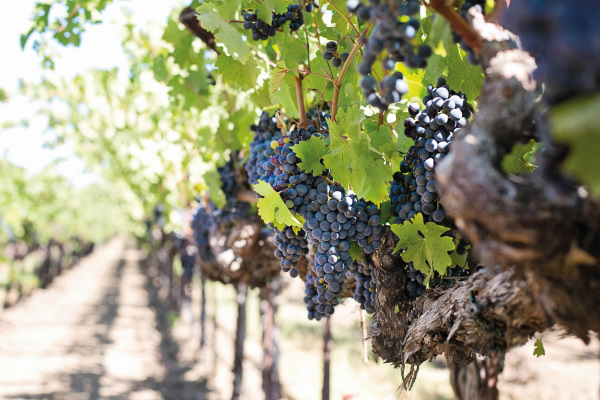Paid for by Wines of Central Greece
The wine areas of Central Greece are among the most historically influential centres of viticulture in existence. The region’s vineyards are a piece of living history with a variety of old dry farmed bush vines lying atop arid hillslopes stretching from the mountains to the sea. All together, Central Greece is home to over a quarter of Greek vineyards, which employ a combination of traditional and modern methods.
Central Greece is home to nine separate Protected Geographical Indication (PGI) Area wine zones that benefit from unique mesoclimates, unique varieties and skilled winemakers; PGI Atalanti Valley, PGI Slopes of Knimida, PGI Opountia Locris, PGI Phthiotis, PGI Parnassos, PGI Thiva, PGI Lilantio Pedio, PGI Evia and PGI Ritsona. The PGI Wines of Greece comprise the Greek ‘Local Wines’ category and some wines of ‘Traditional Appellation’.
Just a short distance from Athens, the five regional units of Central Greece lie along the southern part of the mainland and the island of Evia to the east. Ancient traditions and varieties dominated until the 1950s, when many of the vines were destroyed, leading to the introduction of French and non-native Greek varieties, including Assyrtiko, Cabernet Sauvignon, Athiri and Syrah. Over the past 20 years, the region has experienced a winemaking renaissance focused on indigenous and, in some cases, almost forgotten varieties.
PGI Parnassos is one of the most mountainous regions in Greece. There, cultivated white varieties are Athiri, Assyrtiko, Malagousia and Robola, while reds are Mavroudi, Cabernet Sauvignon, Merlot and Cabernet Franc. PGI Slopes of Knimida, which features vines grown mostly on the southern slopes of Kallidromon, is at a higher altitude, with cooler mesoclimates for wine-growing, allowing for slower ripening and thus the retention of acidity in the grapes. Visitors will find Assyrtiko, Athiri, Savatiano and Kontokladi in whites, Vradiano, Limnio, Mavroudi and Cabernet Sauvignon in reds.
The Valley of Atalanti (PGI Atalanti Valley) stretches across Central Greece, with Parnassos Mountain in the east and the sea to the west, allowing vineyards to cool naturally from a cross sea breeze. Wines produced are dry. The main whites grown in Atalanti are Assyrtiko and Savatiano, while the main red is Cabernet Sauvignon, adapted for over 30 years.
The vineyards of Opountia Locrida (PGI Opountia Locris) are surrounded by mountains and sea to the east, producing whites Athiri, Assyrtiko, Robola and Malagousia, with reds Limnio, Xinomavro, Cabernet Sauvignon and Merlot. Opountia stretches along the south-eastern part of Fthiotida and includes the area of ancient Opous, one of the nine cities of the area mentioned by Homer. The region produces dry white, rose, and red wines, produced by two wineries.
PGI Phthiotis boasts a semi-continental climate, with vines grown on slopes surrounded by mountains. White grape varieties are Aidani, Athiri, Assyrtiko and Malagousia, with reds Vradiano, Mavroudia, Limnio and Aglianico. Said to be the ancient home of the Greek god of wine, Dionysus, PGI Thiva has cold winters and hot summers. Vines from previous fertile soils are now grown on slopes, producing whites Athiri, Assyrtiko, Robola and Malagousia. Reds are Mouchtaro, Agiorgitiko, Cabernet Sauvignon and Cabernet Franc.
PGI Lilantio Pedio wine zone is temperate with moderate winters and cool summers due to the influence of the sea and the Dirfy Mountain. Located on the island of Evia, the PGI produces dry to sweet white, rose and red wines. The area has a long viticultural history associated with the Savatiano variety. Winemaking in Lilantios Pedio has evolved rapidly with additional varieties and types of wine now produced. Whites include Savatiano, Malagousia, Assyrtiko and Athiri. Reds are Vradiano, Mavroudi, Limnio and Aglianico.
PGI Evia, one of the region’s better-known wine areas, has a cooler north and more arid south. Covering the island of the same name, wine production in central and southern Evia employs traditional techniques, while northern Evia offers both Greek and international varieties and many modern wines. Whites include Savtiano, Assyrtiko, Malagousia and Aidani White. Reds are Mandilaria, Vradiano, Agiorgitiko and Liatiko. PGI Ritsona features hilltop vines which receive the moderating effect of a sea breeze, producing whites Savatiano, Malagousia, Assyrtiko and Monemvasia and reds Vradiano, Agiorgitiko, Karabraimis and Mandilaria. One of the traditional wine-growing regions of Greece, PGI Ritsona is located on the mainland of Evia. The region was once known only for white wine and now produces a broader range and styles using modern techniques.
In the heart of the Greek mainland, the Central Greece region is a broad and diverse area for winemaking, producing unique wines with a variety of characteristics. The mixture of local and foreign varieties creates complex notes to the Central Greece wines, with a range of areas and vineyards worth exploring.
Read this article also here

